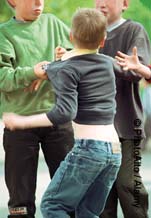How to deal with violent behaviour
Add to My Folder
Involving children in role play will urge them to think about what it’s like to be on the receiving end of bad behaviour

All children should know that violence does not solve anything
In our society, children are exposed to images of aggression from an increasingly early age. They come across these images on the television, through their toys, in computer games and in the world around them. While schools strive for non-violent behaviour, there is no denying that violent imagery can be attractive to young people, perhaps particularly so to boys. Action hero toys introduce children to the idea of heroes and villains ‘fighting it out’ to achieve success, and many are exposed to excessive amounts of violent imagery, for instance in computer games designed for adults rather than children. (An independent review, requested by the Prime Minister, by clinical psychologist Dr Tanya Byron on the effects of video games on children, will be made in March 2008.)
The majority of children understand that violent behaviour is unacceptable in school; that it has no place in a civilised community or society. They realise that aggressive acts will be met with an appropriate sanction. However, there are some children who find it impossible to control their impulses, and who will lash out at classmates or staff, regardless of the consequences. These children might have learned from confrontational and aggressive role models in the home or from influences outside the school gates.
1 Conflicting views
When the message coming from ‘home’ is at odds with what the school or teacher asks, this is very confusing for children. Some parents will advise their children to ‘fight back’ if they are hit, while the school will advocate a non-violent approach. Changing children’s behaviour and attitudes requires a long-term approach and should be a whole-school policy. We need to encourage children to think about ways of handling their anger, and of resolving problems, without resorting to violence.
Already a member? Sign in below.
Published 19 November 2007
Jumping Jax
on 24 January 2010
3. Talking About It
I am surprised you have misquoted the Bible's admonition of "an eye for an eye and a tooth for a tooth"
This was the penalty should two men brawling in the street injure a pregnant woman in the process.
The woman's husband had the right to demand retribution for any damage done to the unborn child. Hence, "an eye for an eye and a tooth for a tooth"
It was meant to emphasise the importance of all life, even the unborn.
It was the Court's decision after the birth to uphold the law and was not an encouragement for the Israelites to take the law into their own hands and mete out these sanctions immediately.